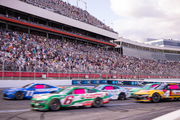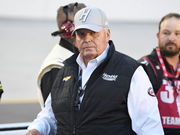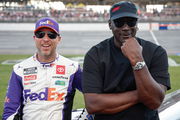
USA Today via Reuters
Nov 6, 2021; Phoenix, AZ, USA; An overall view of the track during the Xfinity Series Championship at Phoenix Raceway. Mandatory Credit: Peter Casey-USA TODAY Sports

USA Today via Reuters
Nov 6, 2021; Phoenix, AZ, USA; An overall view of the track during the Xfinity Series Championship at Phoenix Raceway. Mandatory Credit: Peter Casey-USA TODAY Sports
Days before NASCAR waves the green flag for the 2024 season, the authorities introduced new rules for the Cup Series teams. NASCAR on Wednesday upgraded its rulebook for the Next-Gen cars on 1-mile ovals and less and also for all road courses. The changes have been carried out after a testing session in December on the Phoenix track, by a handful of drivers.
Watch What’s Trending Now!
The upgrade in the Next-Gen car comes after the amalgamation of the drivers’ feedback and NASCAR’s efforts to enhance racing on short tracks and road courses. However, the newly issued mandate won’t apply to the upcoming race Clash at the Coliseum, the season opener race. Nevertheless, delving deeper into the complexities, the former crew chief of Hendrick Motorsports Steve Letarte tried to anatomize the new changes.
ADVERTISEMENT
Aerodynamically adjusted Next-Gen cars to hit road courses in 2024
The test, aiming for aerodynamic and technical changes in the Next-Gen car, saw the participation of six drivers from the Cup Series circuit including Erik Jones, Chris Buescher, Ryan Blaney, Kyle Larson, Corey Lajoie and Christopher Bell. It was carried out to introduce a simplified rear diffuser along with fewer vertical strakes and a strake-free engine panel. However, like the past year, the cars will also retain splitter-stuffers. These changes which are set to be implemented would help in creating a better downforce in the car and help in navigating through the traffic.
Moreover, to balance out the reduction in downforce, the authorities have raised the height of the rear spoiler to three inches. Nevertheless, the aerodynamic changes in the car will be executed after a wind tunnel test on February 13th and a vehicle test in Phoenix on February 20. Speaking on the newly implemented rules and breaking down the changes, NBC’s NASCAR analyst stated, “Aerodynamic adjustment for the short tracks. At road courses at ovals 1 mile and smaller, NASCAR has adjusted the aerodynamic package to hopefully put more maneuverability, behind the wheel and in for the driver.”
Watch this Story: Bubba Wallace Receives Love From Nascar Faithful & Pal Daniel Suarez as He Ties the Knot With Longtime Girlfriend Amanda Carter
ADVERTISEMENT
Drawing a comparison with the setup of the 2023 Next-Gen car, Letarte admitted, “When you watch NASCAR racing in 2023, this was the rear floor and the diffuser of the race car. This is the size, this is the vertical fences or streaks that they have. In 2024 that panel underneath the back shrinks dramatically. This piece is aluminum and is a test piece, but you just see, how smaller it is, how shorter it is, and the width of the vertical fencing.”
Putting the two components side-by-side, Letarte also added, “If I put this side by side, just see the difference in size. That size and width reduces downforce dramatically. But most importantly, it allows the driver to slide the back of the car with a little bit of maneuverability because the rear downforce went away, NASCAR had to add more spoiler back.”
ADVERTISEMENT
“It is not a whole lot, an inch taller and an inch wider on the either side. So overall, all this together, the same amount of downforce but a much different field. The drivers who have tested it said that they can slide the back car around and hopefully adding maneuverability, widening out the race track and most importantly setting up passes in short tracks,” Letarte concluded.
.@SteveLetarte tells you everything you need to know about the new rules package for short tracks and road courses. pic.twitter.com/NWJ7r1aFV6
— NASCAR (@NASCAR) January 11, 2024
But why are the changes being implemented? NASCAR’s Vice President of Vehicle Performance Eric Jacuzzi recently opened up about the newly introduced packages.
ADVERTISEMENT
Top Stories
New Charter Deal Triggers ‘Financial Frenzy’ as NASCAR Teams Set for Massive Payday

Rick Hendrick Strikes Fear in NASCAR Fans With Chevy’s New “Illegal” Car

NASCAR Broadcasters Asked to Issue an Apology to Michael Jordan & Co. After Lawsuit Settlement

What Settlement Agreement Have Michael Jordan & NASCAR Reached? Everything to Know From Evergreen Charters to Payout

Dale Jr. Goes on a Ballistic Rant Calling Out NASCAR’s Obsession With Manufacturing Drama

The need for the upgradation of the existing package of NASCAR
The newly implemented rules are set to be at tracks of one mile and less than one line and also road courses, with the exceptions being Bristol Motor Speedway and Dover Motor Speedway, the tracks with high banking. Eric Jacuzzi, in a recent interview, emphasized the need for the improvement of the racing packages.
The NASCAR official stated how that the car would not be losing the downforce of the car, an issue that has been recurrent in the current conditions. He also asserted that the cars will be able to slide more under the new configuration, without fretting over being caught up in wrecks.
ADVERTISEMENT
Jacuzzi exclaimed, “We felt that would be a benefit, and that was the big takeaway from the driver feedback. At the test, they felt they could really tell that it was more forgiving. They felt they could slide the car, not crazy, but certainly much more than they regularly could without having a performance penalty.”
Read More: The Trade Between Kaulig and Trackhouse Racing Broken Down
With the package set to run on all five road course races in the schedule, it will be interesting to see how the drivers are able to create passes on these tracks without being embroiled in harrowing crashes.
ADVERTISEMENT
ADVERTISEMENT
ADVERTISEMENT
ADVERTISEMENT

